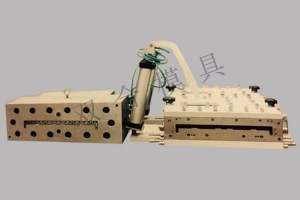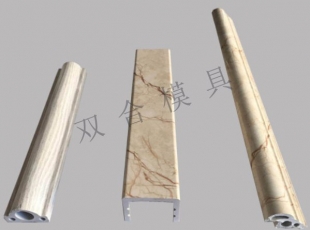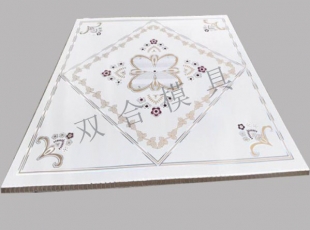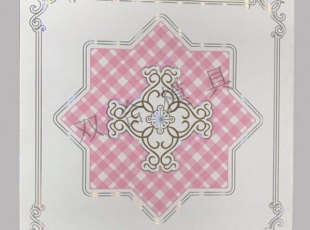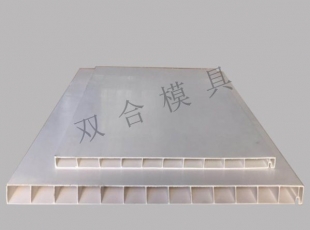Company news
- 热门产品
- 热门新闻
- What should we pay attention to when purchasing aluminum gusset plate production equipment and aluminum gusset plate mol
- What problems will PVC plates formed by gusset mold encounter?
- In what fields are gusset dies used?
- Plug mold caused by temperature of profile mold
- What are the conditions of mold plugging caused by unreasonable design of profile mold?
- KEYWORD
Analysis of common abnormal phenomena in PVC-U Profile mold debugging
Analysis of common abnormal phenomena in PVC-U Profile mold debugging
1 profile bending
The straightness of extruded profiles is an important index to test the product quality of plastic door and window profiles,which directly affects the welding and assembly quality of doors and windows and the installation of hardware accessories.Gb/t8814-1998 stipulates that it is unqualified when the bending amount of the main profiled materials of doors and windows(such as fans,frames,Stiles)is greater than 2mm/m.
There are many factors that cause the bending of extruded products,and the most common are the following aspects:
1.1 uneven discharge of die
The uniformity of die discharge includes two elements,namely"difference of discharge speed"and"difference of parison wall thickness".To judge whether the die discharge is uniform,just use a special shovel to quickly cut 4~5 pieces of parisons with a length of about 20mm and good plasticization at the outlet of the die for measurement.If the length error of each longitudinal side of the parison(taking the average value of each piece)is not more than 10%,and the thickness of the outer wall,inner rib and other parts(due to the off mold expansion effect,the thickness is not equal to the wall thickness of the product)corresponds to the requirements of the product section drawing
It is regarded as qualified.For the bending caused by uneven discharge of the die,the bending direction bends to the side with slow discharge on the premise that the shaping system has sufficient cooling of the parison and the traction resistance is balanced(the influence of cooling effect and traction resistance will be discussed later).The measures to adjust the uniformity of die discharge are as follows:
(1)Check the uniformity of the main gap of the cavity in the setting section of the die,and the gap difference is not greater than 0.02mm;
(2)Check whether there are dead corners,steps or pastes in the flow channel,and polish the cavity to the mirror(RA≤0.02μm);
(3)Check whether the tail cone shunt center is reasonable and adjust it;
(4)Adjusting the local discharge speed of the die can also adopt two different ways of"blocking flow"or"draining flow"in the compression section,diversion section or divergence section(it is strictly forbidden to change the gap of the die setting section).For the area with fast discharge,the damping block can be set or the same material as the mold body can be used to weld the cavity to achieve the purpose of"current limiting";For areas with slow discharge,the purpose of"drainage"can be achieved by locally extending the length of the compression section(i.e.shortening the length of the shaping section),increasing the cavity size of the diversion section,or adjusting the diversion angle of the tail cone.
1.2 the traction resistance of the parison when passing through the sizing cooling system is unbalanced
PVC-U Profile shaping cooling system usually adopts dry wet combination shaping device.In the dry setting section(a series structure in which several setting dies are generally installed on the same base plate),the parison in high elastic state is adsorbed on the cavity wall by vacuuming to form and cool,and slides under the action of the tractor.Due to the relatively complex structure of most profiles and their gradual contraction in the process of sliding along the cavity,the imbalance of traction resistance is very common,which should be mainly analyzed from the following aspects:
(1)Bending caused by unbalanced resistance(mainly in asymmetric profiles)tends to bend to the side with high resistance;
(2)The greater the vacuum adsorption force is,the greater the friction resistance between the parison and the cavity is.The local traction resistance can be changed by adjusting the vacuum adsorption strength;
(3)Check whether the structural size design of grooves and bosses that are prone to generate large traction resistance is reasonable.Table 1 shows the common sealing strip installation groove structure on door and window profiles.In order to avoid large resistance caused by shrinking and hugging the boss when the parison passes through the shaping system,its size design should be gradually reduced and completely simplified;
(4)Check whether the discharge of the product claw is too fast.In order to avoid bad phenomena such as hanging and blocking the mold when the small claw passes through the shaping system(especially the dry shaping section),the design of the mold groove should be more than 20%larger than the small claw at the corresponding part of the product,as shown in 1.3 in Table 1.The design size in the shaping system is 1.6(1.7).At the same time,the inlet of the first shaped mold cavity shall have a 1.5:8(parison)introduction groove
(5)Check the alignment of the cavity in the[BF]drying section,and the deviation should be controlled below 0.05mm.In general,if the center of[JP3]in the rear of the drying section deviates,the extruded profile is easy to bend in the same direction.
The wet setting part mostly adopts the open water tank(there is only a certain shape block at the outlet of the water tank)or the vortex water tank,in which the shape block in the vortex water tank can float up,down,left and right,so as long as the cavity size is designed reasonably,the resistance of the profile passing through this part is generally small,and the influence on the bending of the profile is also small.
1.3 cooling imbalance
The bending caused by unbalanced cooling often occurs in American profiles with long single walls or small-sized materials with large thickness differences.When designing the shaping system of the American push-pull frame mold,because the contact area between the parison and the mold body at the single wall part is twice that of the hollow part,coupled with the influence of internal heat in the cavity,in order to prevent the profile from bending to the side of the hollow body,the cooling water flow at the single wall part should be considered as about 30%of the hollow part;On the contrary,the molding system of the batten should especially strengthen the thick wall
For cooling,spray water directly to this part in the cooling water tank.
In addition,because the profile has a multi-layer inner cavity structure,it is not easy to release the heat in the inner cavity during the cooling process of Traction[JP3].It can be considered to inject compressed gas from the diversion rib of the die into the inner cavity to improve the heat exchange efficiency.
The bending caused by unbalanced cooling can also be corrected by baking the concave side with a 2kW far-infrared electric heating tube at the outlet of the shaping system.
1.4 traction upper and lower tracks are not synchronized
If the traction track is not synchronized,the profile is easy to bend to the side of the track with slow speed.When this happens,just adjust the speed of the tractor.
2.Collapse of edges and corners of products
The collapse of the corners of the products is mainly caused by insufficient discharge of the die or weak vacuum adsorption strength
(1)The stagnation effect(boundary effect)of the corner on the viscous fluid in the die channel system is the main reason for the insufficient discharge of the corner,which can be compensated by changing the channel shape(see Figure 3);
(2)Enhance the sealing effect of the shaping system,especially the dry shaping part(water can be added between each shaping mold),or increase the vacuum adsorption strength and cooling capacity of the collapsed part.
3.There are"fish scale spots"on the surface of the product
It is mainly manifested in the uneven regular ripples like"fish scales"on the surface of the extrudate along the extrusion direction,which greatly destroys the apparent quality of the product.The reasons are:
(1)Poor plasticization.When extruding light meter weight products such as glass beads and covers with extrusion equipment with large rated output,if the traction speed is not high,the melt will often suffer insufficient shear and poor plasticization in the barrel due to low screw speed,resulting in"fish scale spots".To solve this problem,the following measures can be taken:first,improve the traction speed;Secondly,the single screw extruder with small extrusion volume is selected to improve the screw speed;Third,appropriately raise the temperature of the head or barrel;Fourth,modify the mold,increase the length of the die to extend the residence time of the melt in the die and improve the plasticizing quality.
(2)The extrusion rate is too high.In high-speed extrusion,because the disturbance of the solution under high stress or high shear rate is difficult to suppress,it is very easy to develop into unstable flow,which shows as"fish scale spots"in the initial stage of unstable flow;When the extrusion rate is further increased and the melt disturbance is intensified,melt fracture will be caused.
4.There are shrinkage marks on the surface of the product
The shrinkage mark on the surface of the profile usually occurs on the wall corresponding to the inner reinforcement and small boss or on the"t"shaped intersection of the two walls,as shown in Figure 4(①~⑥).The shrinkage mark on the visible surface of the door and window profile(after assembly)(as shown in Figure 4,side a of the push-pull frame)must be eliminated during mold adjustment because it affects the appearance.The causes and solutions of shrinkage marks are as follows:
(1)There is a speed difference between the inner rib and the outer wall,and the extrusion speed of the inner rib often lags behind the outer wall.Internal reinforcement shall be added during mold repair
Feed,and round the corner of the core at the intersection of the inner reinforcement and the outer wall ro 3~R1 to eliminate the tip stagnation effect.Of course,to reduce the mutual interference between the two streams,it is best to feed the inner reinforcement separately,and the confluence length of the inner reinforcement and the outer wall is 8~12mm.
(2)The inner reinforcement is too thick(the thickness of the inner reinforcement should be about 60%of the outer wall).It cannot be completely cooled or the cooling is insufficient,so that the inner rib"shrinks"and produces shrinkage marks.The discharge of inner reinforcement should be reduced,the cooling capacity of the shaping system should be enhanced or the traction speed should be reduced.
(3)The vacuum adsorption force is weak,and the sealing of the shaping system is not good.On the one hand,vacuum adsorption holes should be set at the corresponding parts of the shrinkage trace;On the other hand,a sealing strip or water injection seal is installed between the setting dies of each section.
(4)If the polishing of the core feeding cavity and groove is not in place,resulting in the lagging of the discharge of the inner rib or small bulge,it should be polished to the mirror.
(5)For profiles with a large number of internal bars and easy to produce shrinkage marks,grooves can also be brought when designing products.For example,the groove structure on the door panel not only increases beauty,but also covers defects such as shrinkage marks and splicing marks.

